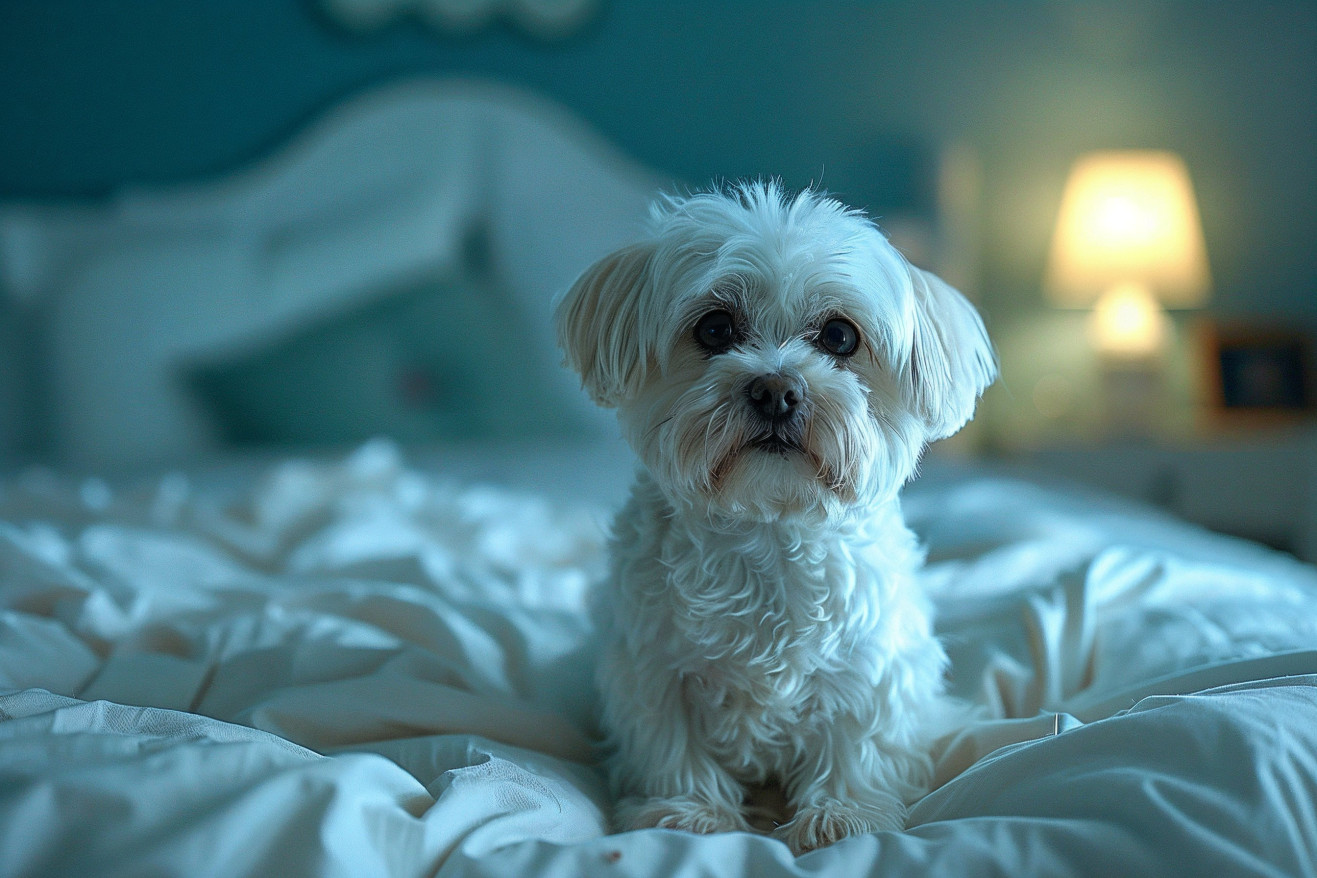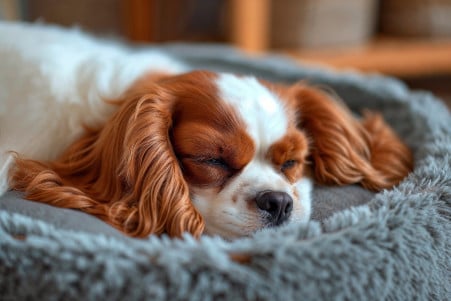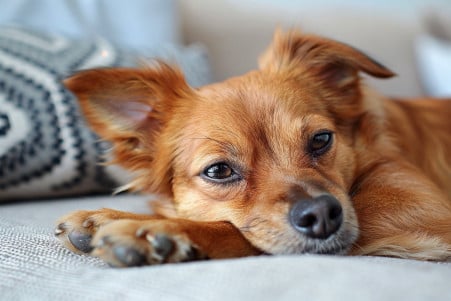Do Dogs Have Nocturnal Behavior? Canine Sleep Patterns Explained
22 February 2024 • Updated 22 February 2024

As the moon rises and the world around them grows dark, you may find yourself asking if dogs are nocturnal. The answer is no. Dogs are not nocturnal animals. Instead, they are primarily diurnal, which means they are most active during the day.
However, dogs also have crepuscular behavior, which means they are most active during the twilight hours of dawn and dusk. In addition, domestic dogs tend to adjust their schedules to match those of their human owners.
This article will take a deep dive into the topic of dog activity patterns, drawing on research from the fields of ethology, veterinary science, and animal behavior.
We will look at how domestication has impacted dog activity patterns and review research that compares the behavior of domestic dogs to their wild ancestors. Finally, we will summarize research on dog circadian rhythms and how human schedules impact dogs to provide a comprehensive look at the many factors that determine when dogs are most active and how they have evolved to live with humans.
Do dogs have nocturnal behavior?
What It All Means: Dog Sleep Patterns, Schedule, and More
Like humans, dogs have different sleep needs, which range from 10 to 14 hours a day, according to Michelson Found Animals. Puppies and senior dogs need more sleep than adult dogs, and the amount of sleep a dog needs can also depend on their size and breed.
A dog’s sleep cycle includes non-REM and REM sleep, which is similar to the sleep cycle of humans. Non-REM sleep helps restore the body’s energy while REM sleep helps maintain cognitive function, according to A-Z Animals.
One way that dogs are like humans is that they often adapt their sleep patterns to their owners, a phenomenon called social sleeping. Dogs are especially good at adjusting their sleep schedules to their owners and will often wait to go to sleep until their owners do.
This adaptability is a sign of the close relationship between humans and dogs and may also be a sign of an evolutionary adaptation to mimic human sleep patterns.
From the strange (sleeping with their eyes open, a behavior that’s also been observed in dolphins and some birds) to the sweet (dogs often dream and may move their paws, bark, or whine in their sleep), there are many normal dog sleep behaviors, according to ASPCA Pet Health Insurance.
Understanding these behaviors can help you understand and support your dog’s sleep. Understanding their natural sleep patterns can also help you understand how domestication has affected and shaped their sleep patterns.
How Domestication Has Impacted Canine Sleep
Domestication has had a major impact on the sleep of dogs compared to their wild ancestors. A study by the MTA-ELTE Comparative Ethology Research Group in Hungary, cited by ScienceAlert, looked at the sleep states of wolves, dogs’ closest wild relatives, and found some significant differences between them and domesticated dogs.
The researchers discovered that wolves have more REM sleep than dogs, which is important for memory consolidation and stress reduction, and that the difference between the two species’ amounts of REM sleep increases with age.
This difference in the sleep of wolves and dogs shows that domestication has brought dogs’ sleep patterns more in line with humans. Over time, domesticated dogs have become more diurnal, which means they are awake during the day and sleep at night, to match humans’ daily schedules.
Meanwhile, breed-specific traits have also led to differences in individual dogs’ sleep-wake cycles, showing that domestication has selected for traits that make dogs better companions and more likely to adhere to human schedules.
These adaptations to sleep show how closely dogs and humans’ histories are intertwined. The fact that dogs’ behavior synchronizes with their owners’ shows how much domestication has impacted dogs’ biology and social behavior.
Dogs and Their Humans Have Synchronized Rhythms
Dogs have shown the ability to synchronize their activity and sleep-wake cycles with their human owners. This behavioral synchronization, as described in a paper in Scientific Reports, shows dogs actively synchronizing their locomotor activity with humans, often mirroring their owners’ schedules and movements. The research also showed that dogs have a natural tendency to stay close to and in synchrony with their human owners, maintaining a high level of proximity.
Building on this, a paper by Mónica Teresa González-Ramírez in PMC explains that humans and dogs who have similar activity levels, such as walking together, have been shown to have stronger relationships and increased happiness. This shows that the relationship between humans and dogs isn’t just a matter of companionship, but it also influences dogs’ behavior, leading to the synchronization of activities.
This can even extend to daily schedules, with dogs synchronizing their rest-activity cycles with those of their humans, including their work and leisure schedules.
This behavioral flexibility shows the deep bond between dogs and humans. It also shows that the impact of human lifestyles on dogs’ diurnal or crepuscular activity is a result of the significant impact of domestication and human relationships on dogs’ biology and social behavior. When you consider the impact of light, it’s clear that dogs aren’t just passive recipients of their human family’s schedules but are actively involved in them.
Shedding Light on Dog Sleep: How Light Affects Canine Behavior
Natural and artificial light exposure are important factors in regulating a dog’s circadian rhythm and can have a big impact on their daily behavior.
A study in PMC found that artificial light at night changes the timing of locomotor activity and shifts foraging behaviors to the day in nocturnal species. This means that the suppression of melatonin production, which is a hormone that tells the body it’s night, could impact dogs in a similar way.
A study in Behavioural Processes found that dogs are sensitive to environmental light, and their sleep patterns change based on the amount of light in their environment. While dogs don’t have an internal drive to be nocturnal like many nocturnal animals, their behavior can still be impacted by light.
As explained in PMC, streetlights and indoor lighting could potentially disrupt dogs’ natural rhythms. If dogs are exposed to these types of light, it could inadvertently lead to a change in their sleep-wake cycle, which could then impact their behavior and health.
When it comes to the well-being of our dogs, it’s important to understand the impact of both natural and artificial light on their sleep and wake cycles so that we can help them in ways that are in line with their biology.
How Light Affects Dogs’ Sleep
Natural and artificial light exposure are important factors in regulating a dog’s circadian rhythm and can have a big impact on their daily behavior.
A study in PMC found that artificial light at night changes the timing of locomotor activity and shifts foraging behaviors to the day in nocturnal species. This means that the suppression of melatonin production, which is a hormone that tells the body it’s night, could impact dogs in a similar way.
A study in Behavioural Processes found that dogs are sensitive to environmental light, and their sleep patterns change based on the amount of light in their environment. While dogs don’t have an internal drive to be nocturnal like many nocturnal animals, their behavior can still be impacted by light.
As explained in PMC, streetlights and indoor lighting could potentially disrupt dogs’ natural rhythms. If dogs are exposed to these types of light, it could inadvertently lead to a change in their sleep-wake cycle, which could then impact their behavior and health.
When it comes to the well-being of our dogs, it’s important to understand the impact of both natural and artificial light on their sleep and wake cycles so that we can help them in ways that are in line with their biology.
How to Help Your Dog Get Better Sleep
It’s important to help your dog maintain a healthy sleep schedule to ensure that they are as healthy and happy as possible. As noted in a special issue on Dog–Human Relationships from the journal Animals, the well-being of both dogs and humans is mutually influenced by their interactions.
One way to help your dog get better sleep is to make sure that they aren’t exposed to artificial light at night, which can throw off their natural circadian rhythms.
You can help by making sure that your dog has a comfortable, quiet place to sleep that is away from artificial light.
In addition, keeping a regular schedule will help support your dog’s circadian rhythm, which will help them know when it’s time to be active and when it’s time to rest.
As noted in ScienceDirect, research has shown that positive social interactions with dogs can have a positive effect on their behavior. This means that if you make sure that your dog has positive, relaxing experiences before bed, you can help them get to sleep more easily.
If you notice that your dog is having trouble sleeping or if there are changes in their sleep patterns, it’s important to talk to your vet. They will be able to give you personalized advice and information based on your dog’s specific needs and any health issues that they may have, which will help ensure that your dog is able to get the quality sleep that they need to be healthy and happy.
With a little bit of attention and care, you can help make sure that your dog gets the rest that they need.
Dog Sleep Patterns: Final Thoughts on Canine Circadian Rhythms
In wrapping up our look at dog sleep patterns, it’s clear that dogs are not nocturnal animals. Instead, they have a flexible diurnal tendency that has been shaped by human schedules.
Domestication has played a key role in this, helping to mold dogs into the social, sensitive animals we know and love today. In the centuries that dogs have lived with humans, they have shown an impressive ability to adapt their behavior, including their sleep–wake patterns, to that of their human companions.
This adaptability is further demonstrated when we consider the impact of natural and artificial light on dogs’ circadian rhythms. The research we’ve reviewed shows that dogs can change their activity patterns based on the amount of light they’re exposed to, but they still tend to follow human schedules.
When we understand and respect our dogs’ natural sleep patterns, we help ensure their health and happiness and strengthen our bond with them. This look at dog sleep patterns has shown that dogs’ ability to adapt to the world around them is as strong and enduring as ever, and it’s a reminder of the importance of understanding and working with the rhythms that dictate their sleep and wakefulness.


